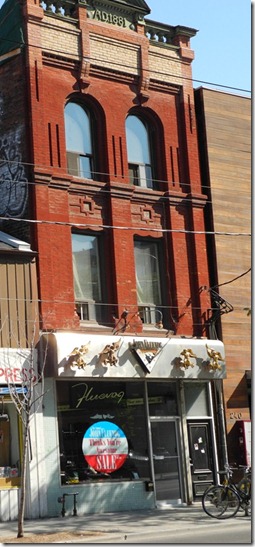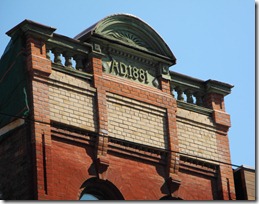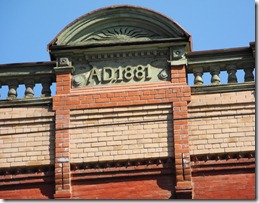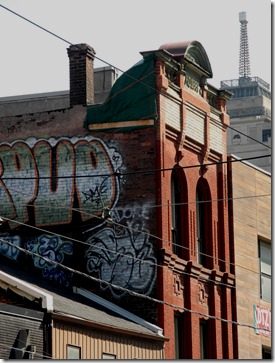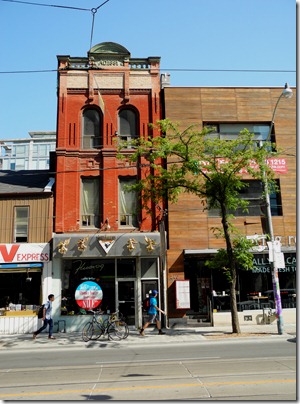242 Queen Street West
In 1864, on the site of the store seen in the above picture, was a small house owned by George Price. His house was on the north side of Queen, a short distance east of John Street. George Price was a merchant, and he occupied the ground-floor level of the home. On the second floor, he rented space to Doctor William Ogden for his office. By 1872, Dr. Ogden occupied the entire building, and his son Albert lived with him. Albert was a “student-at-law.” In 1876, Joseph Gates, a wheelwright, lived in the house.
In 1881, the small two-storey shop was demolished, and the three-storey building you see before you today was erected. This building at 242 Queen Street West is a classic example of the structures built on narrow lots of Queen Street, where small houses had previously been located. Mrs. McNichol operated a dressmaker’s shop on the ground floor, and lived on the second floor with her husband, who was a commercial traveller (salesman). The business was not successful, and in 1882, William Barber opened a grocery store on the site. He continued to operate the business until 1907.
After Mr. Barber retired, several merchants attempted to operate businesses in the building, but none lasted very long. In 1913, Jacob Stein opened a men’s clothing shop, to sell “men’s furnishings” to the families and businessmen of the area. Jacob Stein passed away in 1920, and his wife, Dora, continued the business until 1928, when she sold the shop to Esther Miller.
The narrow building possesses a tall parapet (wall) at the top. This was a common architectural feature during the decade, as it gave the appearance of a more impressive façade, even though the parapet had nothing behind it. In the parapet can be seen the year the building was constructed (1881), and a stone railing that simulates a balcony. In the arc at the peak is a sun-burst pattern, a simple adornment. The third-storey windows are Roman arches, and those on the second-storey are rectangular.
The parapet above 242 Queen Street West
View of the parapet of 242 Queen Street from the west, and graffiti by the famous graffiti artist “Spud.” In the background is the weather beacon on the Canada Life Building.
View of the building from the south side of Queen Street West.
I have spent much of my adult life researching Toronto. Despite the traffic jams and daily congestion, I find Toronto an exciting and vibrant city in which to live. However, I lament the destruction of the city’s architectural heritage. We have very few remaining houses from the 1870s. Because the setting of the houses has now disappeared, I have realized for quite a while that the houses were doomed. It is a pity that they could not have been included in the new development that will be constructed on the site. Condo developers that preserve buildings find that their properties command higher prices and are eagerly sought by purchasers.
I enjoy exploring the city’s past through my writing. One of the books, “The Villages Within”, was nominated for the Toronto Heritage Awards. If interested in novels with a Toronto setting, descriptions of the books are available by following the link: https://tayloronhistory.com/2012/03/22/toronto-author-publishes-seventh-novel/
They can be purchased in soft cover or electronic editions. All books are available at Chapters/Indigo and on Amazon.com. The electronic editions are less that $4 on Kobo and Kindle. Follow the links:
There Never Was a Better Time: http://bookstore.iuniverse.com/Products/SKU-000056586/THERE-NEVER-WAS-A-BETTER-TIME.aspx
Arse Over Teakettle: http://bookstore.iuniverse.com/Products/SKU-000132634/Arse-Over-Teakettle.aspx
The Reluctant Virgin; http://bookstore.iuniverse.com/Products/SKU-000188306/The-Reluctant-Virgin.aspx
The Villages Within: http://bookstore.iuniverse.com/Products/SKU-000175211/The-Villages-Within.aspx
Author’s Home Page: https://tayloronhistory.com/
Authors can be contacted at: [email protected]
